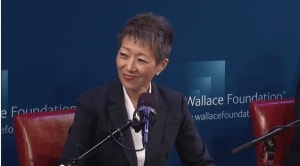WASHINGTON, D.C.: More than half of Americans attend at least one arts event a year; the arts contribute more to the economy than construction or warehousing; and arts exposure at a young age multiplies chances of adult participation by as much as four times.
These are among the findings in new reports from the National Endowment for the Arts (NEA), which set out to discover the impact the arts and cultural industries have on the economy and explore why Americans participate in arts activities. This new information has the potential to help arts providers create strategies to engage individuals and communities.

“The implications from this research are significant,” said NEA Chairman Jane Chu in a statement. “The findings show that there is great diversity in how people engage in the arts, and this gives us a framework to use our creativity to innovate new ways to reach these audiences.”
The data released in the reports dates from 2012, marking the first time the NEA has been able to show a comprehensive view of one year in the life of the arts and cultural sector from three different angles: supply, demand and motivations for consumer behavior.
The first report, titled “When Going Gets Tough: Barriers and Motivations Affecting Arts Attendence,” asked precisely why people attend arts events in areas such as music, theatre, dance and the visual arts. It sought to look past demographics to find specific attitudes, motivations and even barriers for attending arts events at different ages.
It found that for 31 million adults, or about 13 percent of participants, there was an interest in attending an event but they didn’t go. Issues such as lack of time, the location of the event or the thought of attending the event alone were all factors to not attending. Motivations to go included meeting friends or family, learning something new and supporting the local community.
“With the creation of new data analyses like this one, which shows how arts and culture contribute to GDP, the Department of Commerce is providing a more detailed picture of what drives the U.S. economy, growth and job creation,” said Penny Pritzker, the secretary of commerce, in a statement. “Making new data available is another example of how the government is working harder and smarter to produce relevant statistics that better inform individuals, businesses and decision-makers.”
The second of the three reports, “A Decade of Arts Engagement: Findings from the Survey of Public Participation in the Arts, 2002-2012,” used information from the Survey of Public Participation (SPPA), the biggest and most detailed survey of U.S. arts participation with a total sample size over 37,000 adults ages 18 and over, to monitor a decade of arts participation from 2002, 2008 and 2012 along with regional, state and metro-area statistics.
A new question was posed to participants of the 2012 SPPA, and responses revealed that adults who attended performing arts events or visited museums as children were three to four times more likely to keep attending similar events and places as adults. Exposure to the arts during childhood can also be a strong indicator of arts participation as an adult compared to education, gender, age or income.
Further breakdown of the information revealed that women participate in the arts at higher rates than men across all categories except for a select few—men, for instance, are more than twice as likely to use electronic media to create or perform music, and are more likely to create visual art online.
Additionally, the study found that more than 54 percent of all adult Americans, or more than 120 million people, attended at least one live music, theatre, dance performance or an art exhibit within the past year.
The Arts and Cultural Production Satellite Account (ACPSA) is a partnership between the NEA and the Department of Commerce’s Bureau of Economic Analysis. It is the first federal effort to provide an in-depth analysis of the arts and cultural sector’s contributions to the current GDP. The study found that the arts are a bigger driver of the GDP and jobs than previously thought.
The findings from the ACPSA were used in the third report and final report, “The Arts and Cultural Production Satellite Account.” It found that in 2012, arts and cultural production contributed more than $698 billion to the U.S. economy—more than construction and warehousing. A total of 4.7 million workers were employed in the production of arts and cultural goods, and received $334.9 billion in compensation. The arts also had a ripple effect on the overall economy, boosting both commodities and jobs.
The underlying data from the SPA and GSS reports are available through an online resource, the National Archive of Data on Arts and Culture.

